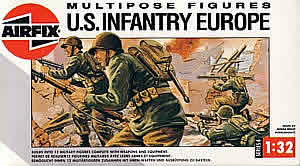| U.S.
Infantry Europe |
 |
|
This is an old, hard to find 1/32 plastic kit from the 1960s that strongly resonates with many figures modelers today. The concept was simple but revolutionary: offer figures that were designed in such a way that body parts could easily be swapped, resulting in an expanded number of poses from the same set. Today’s figure builders consistently request a return to this idea, whether in plastic or resin. But to date no manufacturer is listening. The basic poses share the same problem with some of the earlier Tamiya figure sets, that of disunity. One figure is marching with a carbine over his shoulder, and a second appears to be a commander, standing and looking at a map. The other four figures, however, are in action poses. One is prone, firing an M1 Garand; the second stands with legs apart, pointing an M1 “grease gun”; the third fires a bazooka; and the fourth soldier is in a crouched running position. As the figures were designed to be mixed and matched, you could reconfigure the “non-fighting” poses to have additional dynamic actions. All figures wear the M1943 olive drab jacket, but trousers can be painted in either olive drab or woolen brown. The boots can be problematic. They are calf-length lace-up in style most akin to paratrooper boots. Regular infantry often bartered to get a pair of these boots, prized for their ankle support and easy removal compared to the ankle-high service shoe and canvas gaiters. But it would be quite unusual to see a team of “ground-pounders” all shod in the paratrooper boots. I converted most of my figures to the M1943 boot with gaiter by wrapping a piece of lead foil fashioned with straps and ABER buckles around the upper half of the long boot. Overall the molding of the figures is rather soft. Faces are pretty bland and featureless. You can replace the heads with Verlinden or most Warriors alternatives. Likewise, while suited to the 1/32 size of the figures, the weapons and equipment are simply tooled. The figures are equipped with overly squared M1928 haversacks, cartridge belts, canteens, bayonets, and shovels. The size of these figures can be brought more in line with 1/35 scale by cutting off the boots and then removing up to a quarter inch off the bottoms of the legs. Depending on how the arms are positioned, you might want to remove a bit from where the sleeves and hands meet and carve a new cuff. Again,
with careful painting and updating, these figures hold their own
against most current products. They’re not state-of-the-art,
but they’re still cutting edge. If you see a set, buy it! -tss- |
 |
 |
 |
 |
 |
 |
 |
 |
 |
 |
 |
 |
|
